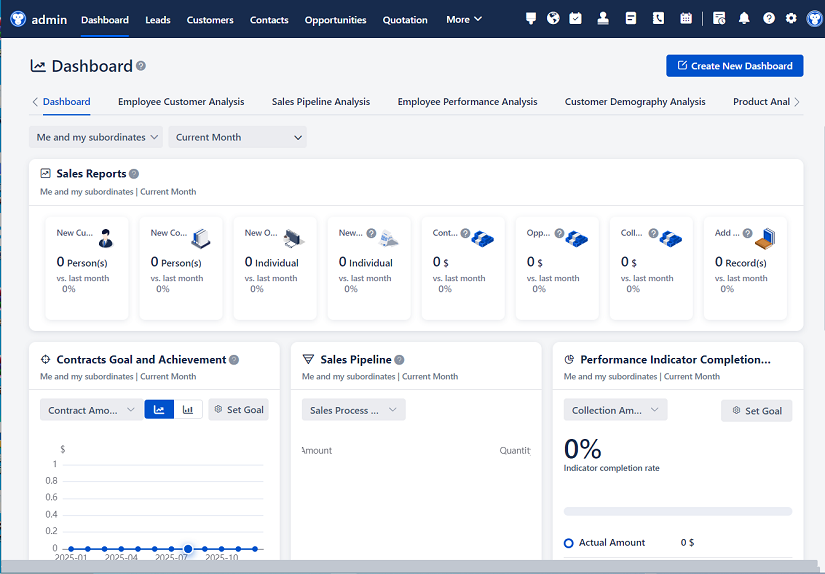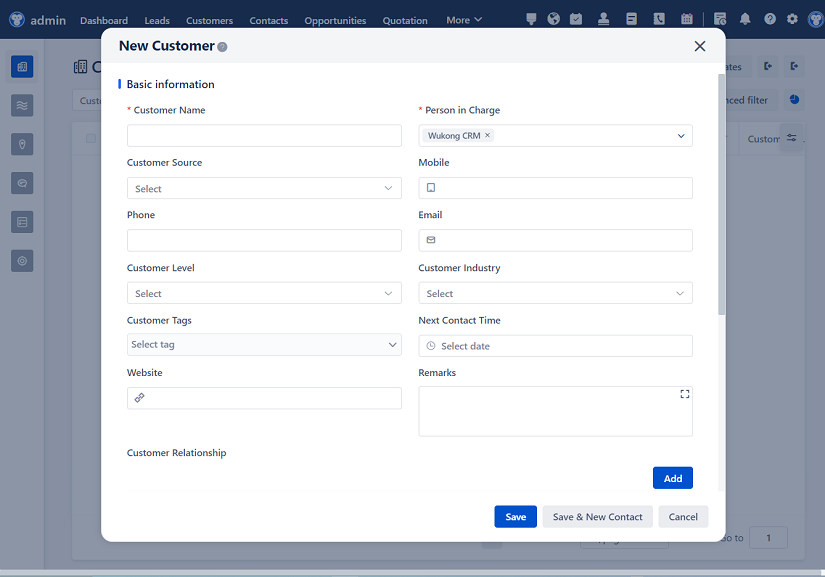
△Click on the top right corner to try Wukong CRM for free
So, let me tell you something — working in CRM customer service? It’s not just about answering calls or replying to emails. Honestly, it’s way more than that. I mean, sure, those are part of the job, but the real heart of it? It’s about building relationships. Like, real, human connections with customers. You know, people come to us with problems, frustrations, sometimes even tears — and our job is to listen, really listen, and help them feel heard.
I remember my first week on the job — I was so nervous. I kept thinking, “What if I say the wrong thing?” But my manager sat me down and said, “Just treat people the way you’d want to be treated.” That stuck with me. And honestly, that’s kind of the foundation of everything we do. Whether it’s a simple question about an account balance or a complex billing dispute, the goal is always the same: make the customer feel supported.
Free use of CRM system: Free CRM

Now, let’s talk about actual responsibilities. One of the main things we do is manage customer accounts. That means keeping everything up to date — contact info, preferences, past interactions. Why? Because when a customer calls back, they don’t want to repeat their story. They want to feel like we remember them. And we should. That’s where CRM systems come in. They’re like our digital memory. I can pull up a customer’s history in seconds and say, “Hey, I see you had an issue last month — is everything okay now?” That little touch? It means a lot.
Another big part of the job is problem-solving. Customers reach out when something’s not working — maybe a product didn’t arrive, or a feature isn’t functioning right. My job isn’t just to fix it — it’s to do it quickly and with empathy. Like, I can’t just say “That’s not my department” and pass them off. No, I own it. I follow up. I make sure it gets resolved. And if I can’t fix it myself, I connect them with the right person and stay in the loop until it’s done.
And you know what? Sometimes the problem isn’t even technical. Sometimes the customer just wants to be understood. I had this one caller last week — she’d been on hold for 20 minutes, and by the time she got to me, she was practically yelling. But instead of getting defensive, I just said, “I’m so sorry you had to wait. That’s not the experience we want for you.” And you know what happened? She calmed down. She said, “Thank you for saying that.” That moment? That’s why I love this job.
Communication is huge. We don’t just talk — we listen. And I mean really listen. Not just to the words, but to the tone, the pauses, the frustration or relief in someone’s voice. Then we respond clearly, kindly, and accurately. No jargon. No robotic scripts. Just real talk. Like, “Let me make sure I understand — you’re saying the app keeps crashing when you try to upload a photo?” That kind of phrasing shows I’m paying attention.
We also handle complaints — and let me tell you, nobody likes getting complaints. But here’s the thing: a complaint is actually a gift. It’s a chance to fix something and turn a frustrated customer into a loyal one. So when someone complains, I don’t get defensive. I say, “Thank you for telling me. Let’s figure this out together.” And most of the time? They appreciate that.
Then there’s the follow-up. I can’t tell you how many times I’ve seen a case marked “resolved” in the system, but the customer still feels ignored. So I make it a point to check back. A quick email: “Just wanted to make sure everything’s working well now.” Or a call: “Hi, it’s Sarah from support — I helped you yesterday, and I just wanted to see if you had any other questions.” That follow-up? It builds trust. It shows we care beyond the ticket number.
Now, let’s talk about the service process — because we don’t just wing it. There’s a flow, a rhythm to how we help people. It starts with intake. When a customer reaches out — whether it’s email, chat, phone, or social media — we acknowledge them fast. Like, within minutes if possible. Even if we don’t have the answer yet, we say, “Got your message. We’re on it.” That simple acknowledgment can calm someone down instantly.
Then we gather information. But we don’t just fire off questions like a robot. We ask in a way that feels natural. “Can you tell me a bit more about what happened?” or “When did you first notice this issue?” And we take notes — detailed ones — so the next person who helps them doesn’t make them repeat everything.
Once we understand the issue, we move to resolution. This is where we use our knowledge base, check policies, maybe consult a teammate. But we don’t disappear for hours. We keep the customer updated. “I’m looking into this for you — should have an answer in 10 minutes.” Transparency builds confidence.
And when we find the solution, we explain it clearly. No vague answers. We say, “Here’s what went wrong, here’s how we’re fixing it, and here’s what we’ll do to prevent it in the future.” And if there’s compensation — like a refund or credit — we explain that too, without making them beg for it.
After resolution, we confirm. “Does that work for you?” or “Is there anything else I can help with?” Because sometimes, one fix leads to another question. And that’s okay. We’re here to help with all of it.
Then comes documentation. I know, it’s not the fun part, but it’s crucial. Every interaction gets logged — what the customer said, what we did, what the outcome was. Why? Because if they call back, the next agent can pick up right where I left off. It keeps the experience seamless.
And finally, feedback. We ask customers, “How was your experience today?” Not because we have to, but because we want to know. If someone says it was great, it feels good. If they say it was bad? We dig in. What went wrong? How can we do better? That feedback loop is how we improve.
One thing people don’t realize? We’re also advocates for the customer inside the company. I’ve flagged product bugs, suggested policy changes, even pushed for better training because of patterns I’ve seen in customer issues. My voice matters — and so does every customer’s.
And let’s not forget about teamwork. We don’t work in silos. If I’m stuck on a case, I can tap a colleague. “Hey, have you seen this before?” Or if someone’s having a rough day with angry customers, we check in. “You good? Want me to take the next call?” That support makes a huge difference.
Training is ongoing too. Products change, policies update, new tools come in. So we’re always learning. Weekly meetings, refreshers, role-playing tough scenarios — it keeps us sharp. And honestly, I appreciate that. It shows the company invests in us, so we can better serve customers.
Now, I won’t lie — it’s not always easy. Some days are exhausting. You deal with angry people, system glitches, tight deadlines. But on the good days? When a customer says, “You’ve made my day,” or “I’ll keep using your service because of people like you” — that’s what keeps me going.

And here’s a secret: the best customer service isn’t about perfection. It’s about humanity. It’s saying “I’m sorry” when we mess up. It’s admitting, “I don’t know, but I’ll find out.” It’s treating people like people, not tickets.

At the end of the day, CRM customer service isn’t just a job. It’s a responsibility — to listen, to care, to act. And when we do it right, we don’t just solve problems. We build loyalty. We create fans. We make people feel valued.
So yeah, it’s more than answering calls. It’s about being the human voice behind the brand. And honestly? That’s a role I’m proud to play.
FAQs (Frequently Asked Questions):
Q: What does a CRM customer service representative actually do every day?
A: Well, it varies, but mostly we help customers with questions, fix problems, update their accounts, and make sure they feel heard. We use CRM systems to keep track of everything so no one has to repeat their story.

Q: Do you just follow scripts, or can you be yourself?
A: Scripts are a starting point, but we’re encouraged to be natural. If I sound robotic, the customer can tell. So we’re trained to use our own words — as long as we’re clear, kind, and accurate.
Q: What if you don’t know the answer to a customer’s question?
A: That happens! I’ll say, “I’m not 100% sure, but I’ll find out for you,” then I’ll check with a teammate or supervisor and get back to them quickly. It’s better than guessing.
Q: How do you deal with angry customers?
A: First, I stay calm. Then I listen — really listen — and acknowledge their frustration. A simple “I’d be upset too” goes a long way. Once they feel heard, we can work on a solution.
Q: Is follow-up really that important?
A: Absolutely. It shows we care beyond just closing a ticket. A quick check-in can turn a so-so experience into a great one.
Q: Can customer service reps suggest changes to the company?
A: Yes! We’re on the front lines, so we see patterns. If something keeps going wrong, we report it. I’ve helped change a return policy because of customer feedback.
Q: What skills do you need for this job?
A: Patience, empathy, good communication, and problem-solving. Tech skills help too, since we use CRM software daily. But most importantly? You’ve got to genuinely want to help people.
Q: Do customers really notice the difference in service quality?
A: All the time. I’ve had customers say, “You’re the first person who actually listened.” That tells me the little things — like remembering their name or following up — really matter.
Q: Is remote work common in CRM customer service?
A: Yeah, a lot of teams work from home now. As long as we have a secure connection and the right tools, we can deliver great service from anywhere.
Q: How do you measure success in this role?
A: Through customer satisfaction scores, resolution time, and feedback. But honestly? Success is when a customer says, “Thanks, you made this easy.” That’s the real win.
Related links:
Free trial of CRM
Understand CRM software

△Click on the top right corner to try Wukong CRM for free